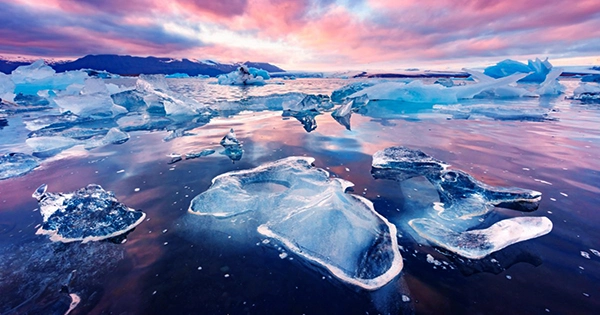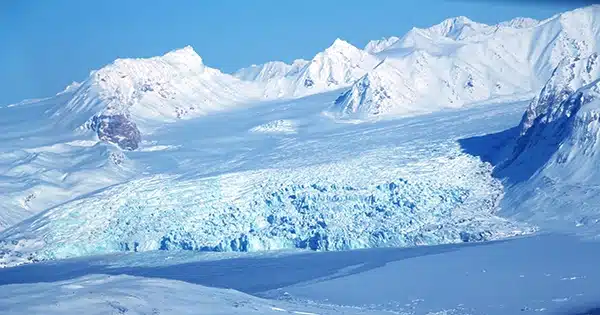The least explored areas of science are subglacial lakes that never see the light of day. These lakes are filled with more stories that have yet to be told than even the planets in our solar system. Where there is water, there is life, regardless of whether that water is at the bottom of a chilly lake, in complete darkness, or more than a half mile below the West Antarctic Ice Sheet.
In order to describe, for the first time, where the tenacious microbes get carbon, the energy source of the moment, and move it through this fiercely desolate system, researchers analyzed the chemical fingerprint of the ocean and microbes recovered from sediments and water at the bottom of a subglacial lake called Mercer Lake. Their findings were published in AGU Advances. They inferred the geologic history of this location using data from sediment, microorganisms, and the carbon cycle, and the conclusions startled them.
While scientists previously believed that the ice over Mercer Lake had been stable for hundreds of millennia, this new research shows that the lake was connected to the ocean around 6,000 years ago, and the West Antarctic Ice Sheet was smaller than it is today. This was a time when the climate was stable compared to the end of the previous ice age and even today’s human climate change.

Ryan Venturelli, the lead author of the study and assistant professor at the Colorado School of Mines, said, “This is the first time we have unequivocal geologic proof that the grounding line of the West Antarctic Ice Sheet, which is like its shoreline where the ice meets the ocean, was at least 250 kilometers further inland than it is today—possibly more. At the University of South Florida College of Marine Science, Venturelli collaborated on the project with Brad Rosenheim, a marine geologist who served as her previous doctoral adviser.
In other words, before re-growing to its current size, the West Antarctic Ice Sheet retreated roughly 155 miles a few thousand years ago—just a few dozen miles short of the distance from New York to Boston. According to Venturelli, “These are actual data from water and sediment samples that can now be used to validate ice sheet models.”
As part of a 25-person team on the famous Subglacial Antarctic Lake Scientific Access, or SALSA, trip, Venturelli and Rosenheim collected the samples from Mercer Lake, a few hundred miles from the South Pole. From December 2018 to January 2019, they were present. The researchers extracted the longest core to date—about seven feet long—from a subglacial lake using a clean-access, bespoke hot water drill. To obtain it, they had to dig through more than half a mile of ice while racing against time as the water-filled hole refroze. The retrieval of a sediment core from a subglacial lake was just the second occasion in history. (The first was discovered in Lake Whillans in 2013.)
“This work is a big step forward for us,” Rosenheim added. “We thought the glacier would retreat back to where it is now, but it went much further back, indicating that the ice is much more dynamic than we realized.” Now we must incorporate this new knowledge into models in order to better forecast what will happen in the future as the world heats.”
To determine how carbon cycles through the system, the scientists employed geochemical procedures such as isotope analysis and radiocarbon dating. They used that in conjunction with established hypotheses about microbial metabolism to determine mathematically when the West Antarctic Ice Sheet’s grounding line receded.
Venturelli stated, “Before this investigation, we had not yet proven the greatest extent of the previous deglaciation.
6,000-year-old carbon tastes just fine: “It turns out that the bacteria living in this environment are hardy little guys who make do with what they have down there,” Venturelli added. “This project demonstrates that where there is water, life can thrive.”
The lake’s bacteria feed on 6,000-year-old carbon introduced when this region was still linked to the ocean.
As a reminder, the sun does not power life in most lakes on Earth through photosynthesis.
“This is not a lake like we know it,” said research co-author and University of Florida microorganism specialist Brent Christner. “In Mercer Lake, in addition to that legacy carbon from 6,000 years ago, microbes can use chemical energy from physical processes associated with the ice sheet itself,” Christner explained.
The rock beneath the ice is broken into minute particles that are mobilized in the water, and microbes—mostly bacteria and Archaea—access those minerals for energy during a process known as chemosynthesis. Archaea are microorganisms that are unique from bacteria seen in other severe conditions, such as hot springs on land and deep sea hydrothermal vents.
The carbon pool in the silt at the bottom of Mercer Lake is at least 100 times larger than any other carbon pool in the cycle, according to Venturelli, and the bacteria use it effectively. They also utilize carbon brought into the system by upstream water bodies. Subglacial lakes can be transitory, resembling a braided subglacial river system rather than a closed-off lake system.
“Think of these lakes not as separate ecosystems, but as a network of communities linked by water and sediment transport,” Christner said.
Painting the bigger picture: The fate of the Antarctic ice sheet has far-reaching ramifications for global sea level rise. According to some calculations, melting the whole West Antarctic Ice Sheet would add more than nine feet to coasts throughout the world.
“There is a lot of hopeless doom and gloom out there in climate science,” Venturelli added. “I find hope in the fact that this work demonstrates that ice sheets are much more dynamic than we previously appreciated, and we need to investigate the concept of reversibility—what were the forcing mechanisms that caused the ice sheet to re-advance to where it is now?—so we can better predict future scenarios.”
Scientists believe there may be more than 650 subglacial lakes in Antarctica, thus they have just scratched the surface of their mysteries with two key data points between this core investigation and the first in 2013. But one thing is certain, according to Venturelli: looking at the glacier’s base, particularly the water, and sediment in these subglacial lake systems, is worthwhile.
“We couldn’t have learned these things by poking at marine sediments from the outside of a ship,” she explained. “Sometimes it takes a fresh look at an old problem to uncover truly exciting results.”
















